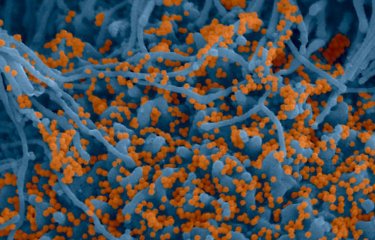-
Article | 2020.06.22
Neurological implications of SARS-COV-2 infection – a transversal study
Aim: The infection of the nasal mucosa and the lungs by CoV-2 may spread to the CNS, including the brainstem, thereby playing a potential key role in the severe respiratory distress observed in COVID-19. Although several clinical observations support this hypothesis, the knowledge in this field is very limited. To fill this gap, we will investigate CoV-2 neuroinvasion in humans, animal...
-
Article | 2020.06.22
Restriction of SARS-CoV-2 replication by coding and non-coding genes
Aim: Knowledge concerning the interaction of SARS-CoV-2 with human cells is sparse. RNA-sequencing analysis, loss-of-function approaches and mechanistic studies will be used to identify and characterize coding and non-coding genes that restrict viral replication. Taking advantage of some of these naturally occurring viral inhibitors may be an effective strategy in the development of novel...
-
News | 2020.06.18
Phylogenetic analysis of SARS-CoV-2: strengths, limitations and over-interpretations
The Institut Pasteur's bioinformatics research teams have been closely involved in the response to COVID-19, working to analyze the sequencing data produced worldwide. On January 29, 2020, the Institut Pasteur, which is responsible for monitoring respiratory viruses in France, was the first in Europe to sequence the whole genome of the coronavirus known as SARS-CoV-2. Since then, it has sequenced...
-
Article | 2020.06.22
Deciphering the virus interactions with the entry receptors in human cells, and their potential inhibition
Aim: Researchers will develop and employ a workflow that combines cryogenic light and electron microscopy imaging modalities with computational analysis and data mining to determine high-resolution in-situ structural images of the virus-spike interactions with cell receptors and with the antibodies that abrogate their cell entry. These studies will provide a blueprint for the design of...
-
Article | 2020.06.22
Drug Repurposing & Design to inhibit the SARS-CoV2 proteases
Aim: Identification of antiviral molecules targeting SARS-CoV2 proteases. Structures of the proteases will be used to screen large chemical libraries in complement of the FDA approved drugs. High Througput Screening (HTS) using dual mCherry-Nanoluc reporter cell lines can screen thousands of compounds. Combined with virtual screening this allows coverage of a large chemical space including...
-
Article | 2020.06.22
rBCG vaccine secreting SARS-CoV-2 antigens
Aim: Mycobacterium bovis BCG is a live attenuated vaccine that is used since almost 100 years for the vaccination against tuberculosis, with a solid safety record in billions of immunocompetent individuals. The aim of the project is to construct recombinant BCG strains that express viral protein(s) of the SARS-CoV-2 virus in fusion with the 6 kD early secreted antigenic target (ESAT-6...
-
Article | 2020.06.22
Investigating the role of apico-basal proteins during SARS-Cov2 infection
Aim: Manipulation of the apico-basal Polarity pathways during infection is a strategy routinely used by numerous viruses. This leads to the mislocalization or degradation of the polarity proteins and participate to the disruption of the epithelial integrity.Nothing is known so far concerning SARS-CoV2 and polarity. In order to better understand SARS-CoV2 physiopathology, this study focuses...
-
News | 2020.06.22
Neurodegenerative diseases: recycling mechanisms open up new avenues for therapy
Alzheimer's and Parkinson's diseases are the most widespread forms of neurodegeneration in humans. Each year, 225,000 new cases of Alzheimer's disease are diagnosed in France, amounting to a total number of 900,000 patients in the country. This figure is expected to reach 2.1 million in 2040, representing a significant burden for public healthcare systems. So far, no efficient treatment options...
-
Article | 2020.06.22
Fiche maladie redirect en Sars-CoV-2 / Covid-19
Fiche maladie redirect en Sars-CoV-2 / Covid-19
-
Document de presse | 2020.06.23
COVID-19 in primary schools: no significant transmission among children or from students to teachers
In late April 2020, scientists at the Institut Pasteur, with the support of the Hauts-de-France Regional Health Agency and the Amiens Education Authority, carried out an epidemiological survey on 1,340 people linked to primary schools in Crépy-en-Valois, in the Oise department. Thanks to the cooperation of the people of Crépy-en-Valois, the survey, which made use of serological tests developed by...


